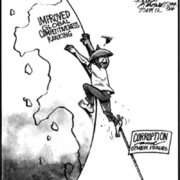ACCORDING to the World Economic Forum (WEF), out of the 144 countries that were surveyed from April to June, the Philippines has improved significantly in terms of competitiveness, moving up ten notches in its ranking in the Global Competitiveness Report — from 75th last year to 65th this year.
It should be noted that the Philippines also elevated ten notches up last year, earning the 75th spot, moving up 20 notches overall so far, under President Noynoy Aquino’s watch.
In its 2012-2013 Global Competitiveness Report, the WEF said: “The Philippines makes important strides this year in improving competitiveness – albeit often from a very low base – especially with respect to its public institutions,” adding that the country is one of a few who made double-digit improvements.
The Philippines registered an overall score of 4.23 out of 7 points in 12 categories which businesses determined as major areas to measure a country’s competitiveness.
This is the first time that the country made it to the upper 50 percent in the global competitiveness survey, says National Competitiveness Council (NCC) Co-Chairman Guillermo Luz.
He added that the Aquino administration has been aiming to make it to the upper one-third of the global competitive rankings by the end of PNoy’s term in 2016.
Countries are graded based on the following categories or “pillars:” [government] institutions, infrastructure, macroeconomic environment, health and primary education, higher education and training, goods market efficiency, labor market efficiency, financial market development, technological readiness, market size, business sophistication, and innovation, as reported by Inquirer.net.
“The sustained and rapid advance of the Philippines in the global competitiveness index owes a lot to improvements in 11 out of the 12 pillars of competitiveness considered by the Global Competitiveness Report,” said Makati Business Club (MBC) chairman Ramon del Rosario during the report’s launch on September 5.
In the institutions category, the Philippines earned the 94th spot(up by 23 notches); 98th spot in the infrastructure category (up seven notches); 36th spot in the macroeconomic environment category (up by 18 notches); 64th in the higher education and training category (up by seven notches); 84th spot in good market efficiency (up by 2 notches); 103rd in labor market efficiency (up by 10 notches); 58th in financial market development (up by 13 notches); 79th in technological readiness (up by 4 notches); 35th in market size (up by a notch); 49th in business sophistication (up by 8 notches); and 94th in innovation (up by 14 notches).
The Philippines did not get an improved ranking in the health and primary education category.
“Out of the 11 indicators listed by the report, the Philippines placed 50 and below in 25 indicators,” reported Philstar.com.
While this is significant good news, del Rosario said that the country still faces a gargantuan feat in order for it to reach upper-third rankings in 2016, especially in terms of infrastructure development and market efficiency — specifically in labor market efficiency.
“Despite these very positive trends, many weaknesses remain to be addressed. The country’s infrastructure is still in a dire state, particularly with respect to sea and air transport, with little or no progress achieved to date,” said Del Rosario.
Infrastructure investment in the country is one of the lowest in the region, albeit increased government spending this year.
The Philippines still lags behind other major Asian economies like Hong Kong (9th place), Taiwan (13th place), South Korea (19th place), Malaysia (25th place), China (29th place), Thailand (38th place), Indonesia (50th place) and India (59th place).
As we continue to gain momentum, let our renewed sense of confidence motivate us to work even harder towards a new goal — from being a factor-driven economy to an efficiency-driven economy.
(AJPress)







